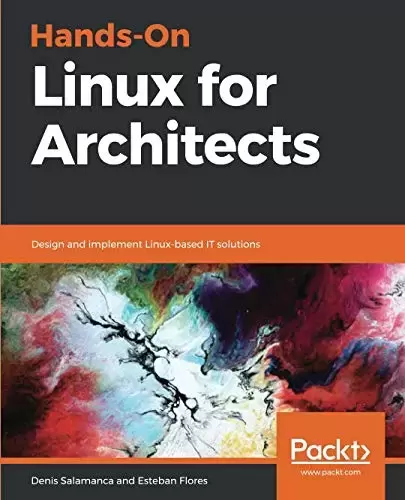
Book Description
Explore practical use cases to learn everything from Linux components, and functionalities, through to hardware and software support
Key Features
- Gain a clear understanding of how to design a Linux environment
- Learn more about the architecture of the modern Linux operating system(OS)
- Understand infrastructure needs and design a high-performing computing environment
Book Description
It is very important to understand the flexibility of an infrastructure when designing an efficient environment. In this book, you will cover everything from Linux components and functionalities through to hardware and software support, which will help you to implement and tune effective Linux-based solutions.
This book gets started with an overview of Linux design methodology. Next, you will focus on the core concepts of designing a solution. As you progress, you will gain insights into the kinds of decisions you need to make when deploying a high-performance solution using Gluster File System (GlusterFS). In the next set of chapters, the book will guide you through the technique of using Kubernetes as an orchestrator for deploying and managing containerized applications. In addition to this, you will learn how to apply and configure Kubernetes for your NGINX application. You’ll then learn how to implement an ELK stack, which is composed of Elasticsearch, Logstash, and Kibana. In the concluding chapters, you will focus on installing and configuring a Saltstack solution to manage different Linux distributions, and explore a variety of design best practices. By the end of this book, you will be well-versed with designing a high-performing computing environment for complex applications to run on.
By the end of the book, you will have delved inside the most detailed technical conditions of designing a solution, and you will have also dissected every aspect in detail in order to implement and tune open source Linux-based solutions
What you will learn
- Study the basics of infrastructure design and the steps involved
- Expand your current design portfolio with Linux-based solutions
- Discover open source software-based solutions to optimize your architecture
- Understand the role of high availability and fault tolerance in a resilient design
- Identify the role of containers and how they improve your continuous integration and continuous deployment pipelines
- Gain insights into optimizing and making resilient and highly available designs by applying industry best practices
Who this book is for
This intermediate-level book is for Linux system administrators, Linux support engineers, DevOps engineers, Linux consultants or any open source technology professional looking to learn or expand their knowledge in architecting, designing and implementing solutions based on Linux and open source software. Prior experience in Linux is required.
Table of Contents
- Introduction to design methodology
- Defining GlusterFS Storage
- Architecting a storage cluster
- Using GlusterFS on cloud infrastructure
- Analyzing Performance in a Gluster system
- Creating a Highly available self-healing Architecture
- Understanding the core components of a Kubernetes cluster
- Architecting Kubernetes on Azure
- Deploying and Configuring Kubernetes
- Monitoring with ELK stack
- Designing an ELK Stack
- Using Elasticsearch, Logstash, and Kibana to Manage Logs
- Solving Management Problems with Salty Solutions
- Designing a salt solution and Installing the software
- Design Best Practices
- Assessments
中文:
书名:Hands-On Linux for Architects: Design and implement Linux-based IT solutions
探索实际使用案例,了解从Linux组件和功能到硬件和软件支持的一切
主要特点
- 对如何设计Linux环境有一个清晰的了解
- 更多地了解现代Linux操作系统(OS)的体系结构
- 了解基础设施需求并设计高性能计算环境
图书描述
在设计高效环境时,了解基础设施的灵活性非常重要。在本书中,您将涵盖从Linux组件和功能到硬件和软件支持的方方面面,这将帮助您实现和调整有效的基于Linux的解决方案。
本书首先概述了Linux的设计方法论。接下来,您将重点介绍设计解决方案的核心概念。随着您的学习,您将深入了解在使用Gluster文件系统(GlusterFS)部署高性能解决方案时需要做出哪些决策。在下一章中,本书将指导您使用Kubernetes作为部署和管理容器化应用程序的协调器的技术。除此之外,您还将学习如何为您的Nginx应用程序应用和配置Kubernetes。然后,您将学习如何实现一个elk堆栈,它由Elasticearch、Logstash和Kibana组成。在最后一章中,您将重点介绍如何安装和配置SaltStack解决方案来管理不同的Linux发行版,并探索各种设计最佳实践。到本书结束时,您将精通为运行复杂应用程序设计高性能计算环境。
到本书结束时,您将深入了解设计解决方案的最详细的技术条件,还将详细剖析各个方面,以便实现和调优基于Linux的开放源码解决方案
你将学到什么
- 学习基础设施设计的基础知识和涉及的步骤
- 使用基于Linux的解决方案扩展您当前的设计产品组合
- Discover open source software-based solutions to optimize your architecture
- 了解高可用性和容错在弹性设计中的作用
- 确定容器的作用以及它们如何改进您的持续集成和持续部署管道
- 通过应用行业最佳实践,深入了解如何优化和制作具有弹性且高度可用的设计
Who this book is for
这本中级书籍面向Linux系统管理员、Linux支持工程师、DevOps工程师、Linux顾问或任何希望学习或扩展他们在基于Linux和开源软件的架构、设计和实现解决方案方面的知识的开源技术专业人士。必须有Linux方面的工作经验。
目录表
- 设计方法论导论
- Defining GlusterFS Storage
- Architecting a storage cluster
- 在云基础架构上使用GlusterFS
- 分析Gluster系统中的性能
- 创建高度可用的自愈架构
- 了解Kubernetes集群的核心组件
- 在Azure上架构Kubernetes
- 部署和配置Kubernetes
- Monitoring with ELK stack
- Designing an ELK Stack
- 使用Elasticearch、Logstash和Kibana管理日志
- 用咸的解决方案解决管理问题
- 设计盐溶液并安装软件
- Design Best Practices
- 评估
评论前必须登录!
注册